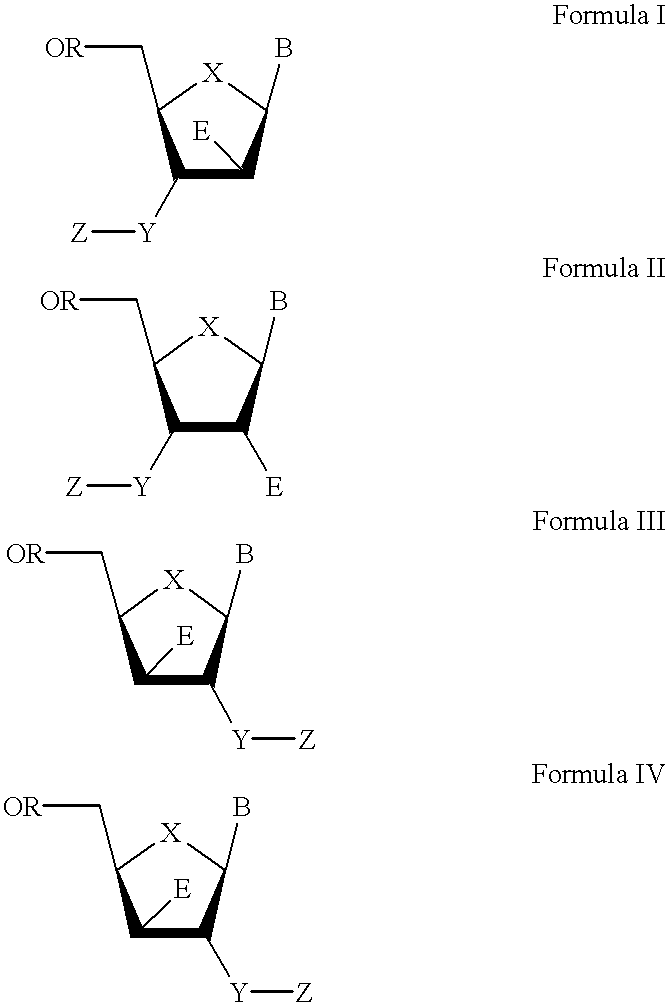3'-or 2'-hydroxymethyl substituted nucleoside derivatives for treatment of hepatites virus infections
a technology of hepatitis virus and nucleoside derivatives, which is applied in the direction of biocide, drug composition, peptide/protein ingredients, etc., can solve the problems of difficult challenge to the treatment of the virus, inactive agents, and significant number of people infected by unknown means
- Summary
- Abstract
- Description
- Claims
- Application Information
AI Technical Summary
Benefits of technology
Problems solved by technology
Method used
Image
Examples
example 2
[0161] 5-O-{tert-Butyldimethylsilyl-2,3-dideoxy-2-fluoro-3-[N-(tert-butyldimethylsilyloxy)-N-methylamino]}-arabino-1,4-lactone (159): A mixture of 158 (5.50 g, 18.7 mmol), TBSCl (3.10 g, 20.6 mmol) and imidazole (2.80 g, 41.2 mmol) in anhydrous DMF (90 niL) is stirred under argon atmosphere at room temperature overnight. After addition of water, the resulting mixture is extracted with methylene chloride. The organic layer is washed with brine, dried over Na.sub.2SO.sub.4, filtrated, and concentrated. The residue is purified with flash column chromatography over silica gel eluting with 5% EtOAc / petroleum ether to give compound3(7.10g,93%)asanoil. .sup.1HNMR(CDC1.sub.3)65.50(br, lH,H-2),4.38(bs, 1H,H-4), 3.80 (m, 3H, H-3 and H-5), 2.69 (s, 3H, NCH.sub.3), 0.85 (s, 18H, 2t-Bu), 0.08 (m, 12H, 4SiCH.sub.3). .sup.13C NMR (CDCl.sub.3) .delta.78.6, 78.5, 70.1, 69.7, 61.1, 47.7, 26.4, 26.3, 18.8, 18.2, -3.9, -4.1, -4.8,-4.9.
example 3
[0162] 5-O-{tert-Butyldimethylsilyl-2,3-dideoxy-2-fluoro-3-[N-(tert-butyld-imethylsilyloxy)-N-methylamino]}-arabino-1,4-lactol (160): To a solution of compound 159 (5.45 g, 13.5 mmol) in dry CH.sub.2Cl.sub.2 (80 mL) at -78.degree. C. is added DIBAL (14.9 mL, 1.0 M in hexane) in an argon atmosphere. The reaction mixture is stirred at -78.degree. C. for 1 hour, and quenched with methanol (10 mL) and followed by saturated NH.sub.4Cl. After the resulting solution is warmed 3to room temperature, solid materials are removed by filtration over Celite and the filtrate is extracted with methylene chloride. The organic layer is washed with brine, dried over Na.sub.2SO.sub.4, filtrated, and concentrated to give the crude lactol 160 (5.07 g) as a colorless oil which was directly used in the next step without further purification.
example 4
[0163] General procedure for synthesis of 5'-O-tert-butyldimethylsilyl-2', 3'-dideoxy-2'-fluoro-3'-[N-(O-tert-butyldimethylsiloxy)-N-methylamino]-D--arabinofuranosyl nucleosides (162): To a solution of crude lactol 160 (0.409 g, 1 mmol), Et.sub.3N (0.162 g, 1.6 mmol) and n-Bu.sub.3N (0.037 g, 0.2 mmol) in dry CH.sub.2Cl.sub.2 (1 mL) at -40.degree. C. is added MsCl (0.149 g, 1.3 mmol) dropwise in an argon atmosphere. After stirring at room temperature for 1 hour, the resulting mixture is diluted with methylene chloride, washed with water, brine, dried over Na.sub.2SO.sub.4, filtrated, and concentrated to give crude chloro sugar 161 as a yellowish oil which is used in glycosylation without further purification.
[0164] A mixture of TMS-protected base (3 mmol) and the crude chloro sugar 161 in ethanol free chloroform (5 mL) is refluxed overnight. After the addition of water, the resulting mixture is extracted with methylene chloride. The organic layer is washed with brine, dried over Na....
PUM
| Property | Measurement | Unit |
|---|---|---|
| Electric charge | aaaaa | aaaaa |
| Molar density | aaaaa | aaaaa |
| Molar density | aaaaa | aaaaa |
Abstract
Description
Claims
Application Information
 Login to View More
Login to View More - R&D
- Intellectual Property
- Life Sciences
- Materials
- Tech Scout
- Unparalleled Data Quality
- Higher Quality Content
- 60% Fewer Hallucinations
Browse by: Latest US Patents, China's latest patents, Technical Efficacy Thesaurus, Application Domain, Technology Topic, Popular Technical Reports.
© 2025 PatSnap. All rights reserved.Legal|Privacy policy|Modern Slavery Act Transparency Statement|Sitemap|About US| Contact US: help@patsnap.com



